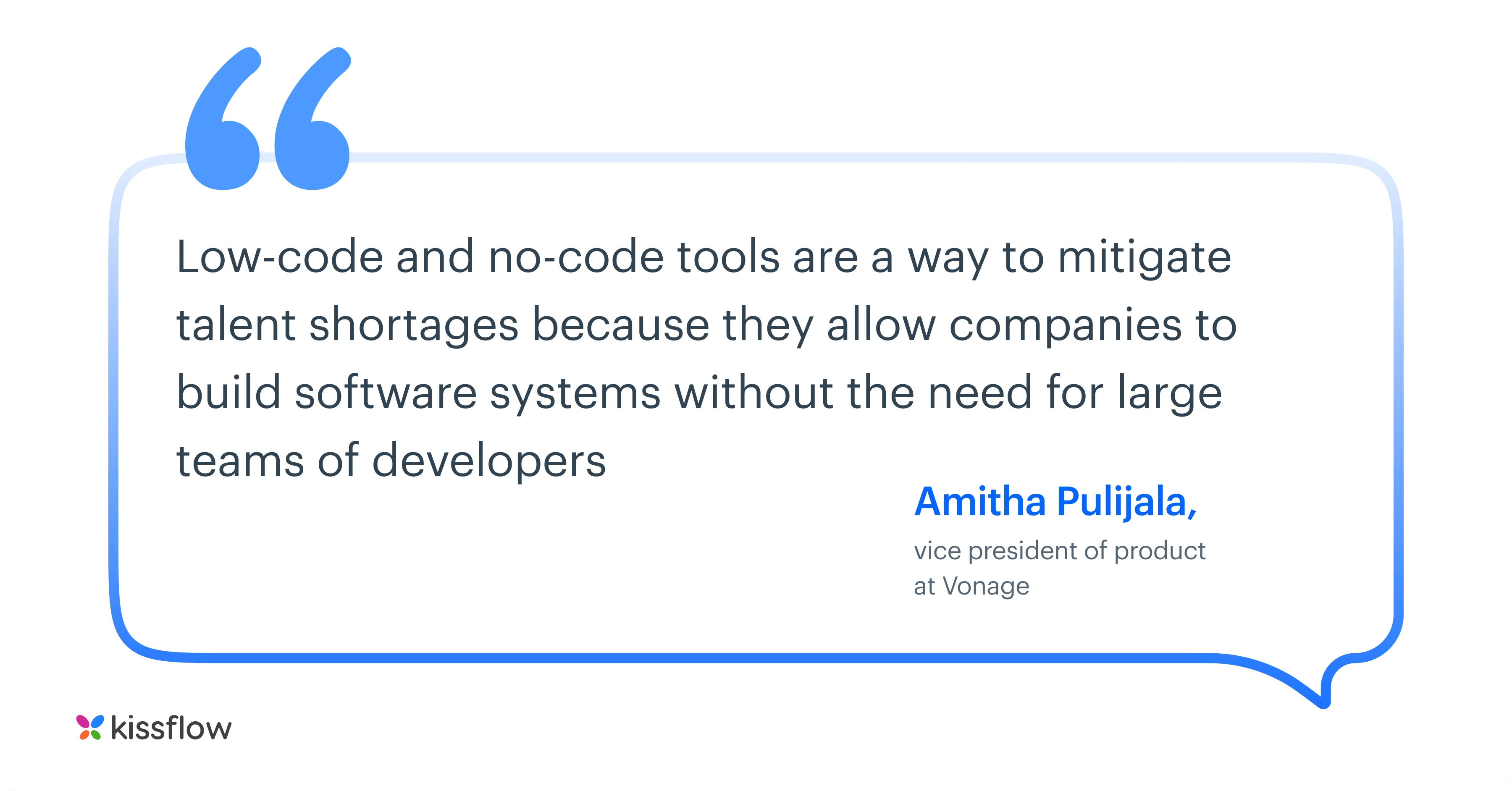
- >
- Low code platform>
- History of low-code platforms
The History of Low-Code Development Platforms: From Innovation to Industry Standard
Digital transformation has shifted from being a buzzword to an absolute necessity for enterprises across every industry. But here's the challenge: most CIOs are struggling to keep pace with their digital transformation initiatives as the demand for business applications continues to skyrocket beyond what IT departments can realistically deliver.
To bridge this clear talent shortage, enterprises are rapidly adopting low-code platforms that dramatically reduce the barrier to entry in application development. The numbers tell a compelling story. According to recent industry analysis, 87% of enterprise developers now use low-code platforms for at least some of their development work. This isn't a niche solution anymore; it's become mainstream.
The trajectory is equally impressive. Industry analysts predict the low-code market will experience sustained growth of 21% annually, reaching approximately $50 billion by 2028. Meanwhile, the U.S. low-code development platform market specifically is expected to grow at a CAGR of 19.20% from 2025 to 2033, ultimately reaching $5.16 billion by 2033.
What exactly is low-code?
Low-code takes a visual approach to software development by allowing users to build applications and processes with minimal coding expertise. Instead of wrestling with complex programming languages, users leverage intuitive drag-and-drop capabilities to quickly build business apps that solve real problems.
By simplifying the app development process, low-code platforms empower even business users to build applications independently while still maintaining IT governance and avoiding the shadow IT problems that plague many organizations.
The early days: Where low-code really began
Low-code technology traces its roots back to the early 2000s, emerging alongside the rise of rapid application development (RAD) platforms. These early platforms aimed to provide a more visual, drag-and-drop approach to application development, fundamentally changing how developers could build applications faster and with significantly less hand-coding.
The real turning point came in 2014 when Forrester Research officially coined the term "low-code" to classify development platforms that focused on simplicity and ease of use. However, the concept itself predates the name. Research indicates that the term "low-code development" was first mentioned in a 2011 report examining new productivity platforms for building custom applications. By 2012, Bubble launched as the first no-code platform, enabling visual programming by replacing traditional coding entirely.
By the mid-2010s, low-code had evolved from an experimental approach into mainstream technology, embraced by organizations of all sizes for its ability to dramatically speed up development cycles and reduce costs.
To say that low-code development platforms have made an impact in the world of programming would be an understatement. They've fundamentally revolutionized the way companies and developers work, shifting the balance of power from highly specialized programmers to a broader range of technical and non-technical users.

The Ultimate Beginner's Guide to Low-Code
Thank you for downloading!
The evolution of programming languages: Setting the stage
To understand why low-code platforms became inevitable, we need to look at the broader evolution of programming languages. The term "programming languages" might evoke thoughts of C, C++, Java, SQL, and other computer languages with complicated syntaxes and seemingly endless lines of code. But programming didn't start there. That particular origin story begins much earlier.
The 1940s: When programming was painful
In the 1940s, the first electronic computers came into existence. But there was a significant problem. Early assembly languages were horribly complicated. Programming with them was like trying to carve Michelangelo's David with a toothpick. There had to be a better way.
Enter FORTRAN: The first breakthrough
A breakthrough arrived with IBM's invention of FORTRAN. The fact that it wasn't just a laboratory experiment but was actually functional and deployable made it revolutionary and incredibly popular. Another factor that made FORTRAN so groundbreaking was its excellence at high-performance computing. Many of the world's modern supercomputers still use it today, and benchmark programs built with FORTRAN continue to push these machines to their limits.
But FORTRAN still had limitations. It was primarily useful for scientific and numeric computing. It wasn't as intuitive as people needed it to be, and it was limited in scope and application. That's where COBOL came in to fill the gaps.
The internet changes everything
The Internet became a massive platform where different systems running different technologies all had to work seamlessly together. Because of this interconnected reality, programming languages had to evolve rapidly to support that need.
Web applications became more complex and popular. Browsers evolved into sophisticated platforms. Developers started using smaller, simpler scripts for specific tasks. Instead of requiring a complete programming language for every function, there was a shift toward specialization. If a language could do one thing exceptionally well, it was valuable. Otherwise, it fell by the wayside.
Applications needed to be developed at a faster pace, and programming languages had to be accessible enough to support that accelerated timeline. This period marks when concepts like rapid application development and low-code actually started taking shape. Modern languages focused on helping developers speed up the development process, not spend hours hunting for that one missing semicolon.
Great examples of this evolution include PHP, JavaScript, and Python, languages that prioritized developer productivity and ease of use.

Forrester, Gartner, and the Low-code love affair
Forrester coined the term, and Gartner helped them introduce it to the masses. But they both have very similar definitions of what low-code is.
Forrester says:
"Low-code platforms enable rapid delivery of business applications with a minimum of hand-coding and minimal upfront investment in setup, training, and deployment"
Gartner has a similar definition:
"Low-code development both describe platforms that abstract away from code and offer an integrated set of tools to accelerate app delivery"
But what does "abstract away from code", "an integrated set of tools to accelerate app delivery", and "rapid delivery of business applications" mean when you strip away the tech speak?
Breaking down the Forrester low-code definition
When analysts talk about low-code platforms enabling "rapid delivery with minimal hand-coding," they're describing a fundamental shift in how software gets built. Instead of developers writing thousands of lines of code by hand, low-code platforms provide pre-built components, templates, and visual interfaces that do the heavy lifting.
Industry research has consistently emphasized that these platforms aren't just about speed. They're about democratizing development, enabling business users to participate directly in creating the applications they need without becoming professional programmers.
According to the Wave reports on low-code platforms, the market has matured significantly. The 2025 evaluation for Low-Code Platforms for Professional Developers assessed leading vendors and found that successful platforms now balance innovation with core product stability and commercial viability.
Learn more: How Enterprise low code apps simplify digital operations.
The current state: Low-Code No-Code market in 2025-2026
The low-code and no-code market is experiencing explosive growth that shows no signs of slowing down. Let's look at what the latest data reveals:
Market size and growth projections
The global low-code market generated $30.1 billion in revenue in 2024 and is projected to reach $101.7 billion by 2030, representing remarkable expansion at a compound annual growth rate of 22.3%. North America continues to lead adoption, driven by businesses racing to solve development challenges and accelerate digital transformation initiatives.
By 2026, Gartner predicts that low-code development tools will account for 75% of new application development, up dramatically from 40% in 2021. This massive shift reflects mounting pressure on organizations to adapt quickly to evolving market conditions and customer expectations.
The rise of citizen developers
Perhaps the most significant trend is the democratization of development. By 2026, developers outside of formal IT departments will account for at least 80% of the user base for low-code development tools, up from 60% in 2021. This shift is being driven by democratization initiatives and the growing sophistication of low-code platforms.
Jason Wong, a Gartner analyst, explains: "The high cost of tech talent and a growing hybrid or borderless workforce will contribute to low-code technology adoption. Due to the flexible, intuitive, and self-service features of low-code development tools, business technologists and citizen technologists are developing lightweight solutions to meet business unit needs for enhanced productivity, efficiency and agility."
In practical terms, 41% of U.S. businesses now have active citizen development initiatives, and 20% of those without such programs plan to launch them soon. This represents a fundamental shift in how organizations approach application development.
Enterprise adoption and ROI
The enterprise adoption story is compelling. Currently, 100% of enterprises report getting positive ROI from their low-code adoption, which demonstrates that a well-executed low-code strategy can power digital transformation with minimal security concerns when implemented correctly.
Large enterprises are leading the charge. Microsoft Power Platform alone boasts 56 million monthly active users, representing 27% year-over-year growth. This kind of adoption at scale validates the enterprise readiness of modern low-code platforms.
According to KPMG's 2022 survey of 715 companies across Europe, the Middle East, and Africa, around 60% of company managers consider low-code development "critical to very critical" for their business operations and strategy.
Speed and efficiency gains
The productivity improvements are staggering. Low-code platforms can reduce development time by 90% compared to traditional coding approaches. In a global survey on low-code development speed, 29% of respondents said low-code is 40-60% faster than traditional methods, while another 29% reported speeds of 61-100% faster.
Research found that low-code software development helps developers create cloud-native applications more than 10 times faster with 70% fewer resources. Companies using low-code platforms often see applications built and deployed in under three months, a timeframe that would be impossible with traditional development approaches.
The AI integration wave
The integration of AI and machine learning is driving the next phase of growth for low-code platforms. Nearly every major low-code and digital process automation vendor is now adding AI-enhanced capabilities, sometimes referred to as "TuringBots."
Industry experts predict that by 2025, no-code and low-code platforms will increasingly integrate code-first capabilities powered by AI, blending simplicity with flexibility. Ed Macosky, CPTO at Boomi, notes: "By 2025, no-code tools will increasingly integrate code-first capabilities, blending simplicity with flexibility. This shift empowers teams to start with intuitive interfaces while retaining the depth and scalability of code."
Microsoft's vision exemplifies this trend. John Bratincevic, an analyst, wrote in the 2025 Wave report: "Microsoft's vision is exemplary, with an unflinching focus on AI-infused use cases and AppGen's potential to disrupt both software development and the core economics of enterprise applications."
Industry evaluation of Low-Code platforms
The Wave reports on low-code platforms have become the industry standard for evaluating vendors. The 2025 assessment for Low-Code Development Platforms for Professional Developers evaluated platforms across multiple categories including strategy, capabilities, and customer feedback.
Key findings from the latest low-code platform research include:
Leaders in the Market: Platforms like OutSystems, Microsoft Power Platform, and ServiceNow were recognized as leaders in the evaluation. OutSystems, the only leader focused solely on low-code and rapid development, received particular praise for its superior UX development, scalable architecture, and data modeling tools.
AI Integration: According to industry research, platforms that successfully integrate AI assistance and have comprehensive roadmaps for AI-driven development are positioning themselves for long-term success.
Professional Developer Focus: The 2025 evaluation specifically assessed platforms for professional developers, recognizing that low-code isn't just for citizen developers. Professional developers are increasingly using low-code platforms to accelerate their work on complex applications.
Why low-code platforms are inevitable
At the end of the day, business leaders care about a straightforward list of outcomes. They want to spend less money, improve productivity, waste less time, and generate more revenue. Low-code platforms deliver on all these fronts, which is why their success is essentially inevitable.
The cost equation
You don't need to invest in expensive, lengthy training programs for your employees. Low-code platforms allow teams to build applications faster with less training overhead. The average company has avoided hiring two IT developers by using low-code tools, resulting in approximately $4.4 million in increased business value over three years from the applications they designed internally.
Companies save an average of 40% in development costs and reduce time-to-market by 25% when using low-code tools. These aren't marginal improvements. They're transformative changes that directly impact the bottom line.
Addressing the developer shortage
The United States faces a critical developer shortage, expected to reach 1.2 million unfilled positions by 2026, growing from 500,000 in 2025. Traditional education systems simply cannot produce developers fast enough to meet exploding demand.
Currently, 82% of organizations struggle to hire qualified engineers, with positions remaining unfilled for months. Compensation inflation drives unsustainable cost increases, and technical debt accumulates as teams struggle with capacity constraints.
Low-code platforms offer a practical solution to this crisis. By enabling business users and less technical staff to build applications, organizations can redirect their limited pool of professional developers to focus on more complex, high-value work.
Improving collaboration
Low-code platforms break down traditional silos between IT and business teams. Currently, 70% of IT teams report improved collaboration when using low-code tools, and 59% of low-code projects involve direct teamwork between IT and business departments.
This collaborative approach ensures that applications more closely align with actual business needs, reducing the translation losses that often occur when business requirements get interpreted by developers who lack domain expertise.
Real-world impact
The statistics demonstrate real-world impact. Automation enabled by low-code platforms slashes manual errors by up to 85%. By 2025, 75% of large enterprises will be using four or more different low-code tools for various use cases. Over 90% of no-code users believe these tools helped their companies grow faster.
Explore the best low-code platforms in the market updated 2025 - 2026 list
The future: What's next for low-code
Three possible scenarios according to industry research
Research analysts have outlined three potential futures for the low-code market:
Scenario 1: Steady Growth (Most Likely) This scenario, which industry experts consider most probable, sees low-code and digital process automation growth being driven by AI integration. Under this trajectory, the low-code market would grow to approximately $30 billion by 2028, maintaining its historical growth rate of around 21% annually.
Scenario 2: Explosive Growth This optimistic scenario assumes that low-code market growth will roughly follow the growth trajectory for generative AI, predicted at 33% per year. Under these conditions, the market could approach $50 billion by 2028, representing one of the fastest-growing segments in enterprise software history.
Scenario 3: Market Slowdown (Least Likely) Analysts consider this the least likely outcome. It would occur as a result of conditions like a bad economy, market saturation, or several high-profile security incidents tied to citizen developers. In this scenario, growth would slow to around 11% over five years, roughly in line with the commercial software market as a whole.
Mission-critical applications by 2029
Looking further ahead, Gartner predicts that by 2029, low-code platforms will power 80% of mission-critical applications globally. This represents a profound shift from viewing low-code as appropriate only for simple applications to recognizing it as suitable for enterprise-scale, business-critical systems.
Industry-specific solutions
As low-code technology matures, it's evolving into industry-specific solutions with pre-built templates and compliance features. Healthcare providers use these tools for better patient care coordination and virtual doctor visits. Educational institutions create virtual classrooms and administrative systems. Retailers design mobile storefronts and loyalty programs.
This industry-focused approach makes low-code accessible even to organizations without extensive technical resources, further accelerating adoption.
The role of professional developers
Keep in mind that low-code doesn't mean there's no code involved at all. It makes development significantly easier for existing developers, allowing them to create applications without spending countless hours on repetitive coding tasks. Much of the development becomes visual, using modules and templates that can be configured and customized as needed.
Professional developers increasingly appreciate low-code platforms because they accelerate routine work while still allowing for customization and extension through traditional code when necessary. The platforms act as force multipliers, letting skilled developers accomplish far more than they could with traditional approaches alone.
Shomron Jacob, Head of Applied Machine Learning & Platform at Iterate.ai, predicts: "Enterprise low-code adoption will accelerate as platforms mature to handle complex business logic and integration requirements. Organizations will develop and deploy mission-critical applications using visual development tools that generate production-grade code, significantly reducing development time and costs while maintaining application quality and security."
Learn more: Open source low-code platform
Low-code vs No-code: Understanding the distinction
While often mentioned together, low-code and no-code platforms serve different purposes and audiences. Understanding this distinction is important for organizations evaluating their options.
Low-code platforms
Low-code development platforms are designed for users with some technical knowledge. They provide visual development tools but still allow (and sometimes require) custom coding for complex scenarios. These platforms are ideal for professional developers looking to accelerate their work or for technical business users who understand basic programming concepts.
Industry evaluations focus heavily on this category, assessing platforms based on their ability to serve professional developers building complex, scalable applications.
No-code platforms
No-code platforms are designed for users with no programming experience whatsoever. They provide entirely visual interfaces with drag-and-drop functionality and pre-built templates. No-code platforms prioritize simplicity and ease of use above flexibility and customization options.
The industry perspective on Low-code and No-code
Research on low-code and no-code platforms emphasizes that organizations often need both approaches. Analysis suggests that successful digital transformation strategies incorporate multiple tools matched to different use cases and user personas.
Simple departmental apps and workflow automation might use no-code tools deployed by business users. More complex applications requiring integration with multiple systems and custom business logic might use low-code platforms with professional developer involvement.
Learn more: Best low-code wep app builders
Real-world success stories
The practical impact of low-code platforms is visible across industries:
Financial Services: Banking and financial services organizations command 27% of the low-code market share. These institutions leverage low-code for everything from loan origination systems to risk assessment tools, meeting strict regulatory requirements while accelerating time to market.
Manufacturing: Manufacturing companies use low-code platforms to create custom solutions for supply chain management, inventory tracking, and quality control, adapting quickly to changing production needs.
Healthcare: Healthcare providers build patient management systems, appointment scheduling tools, and compliance tracking applications using low-code platforms, improving care coordination while managing sensitive data securely.
Conclusion: Low-Code is the present and future
Low-code isn't some distant future possibility. It's here. It's now. It's already transforming how organizations build software and respond to business challenges. If you're not already leveraging low-code platforms, you're falling behind competitors who are building and deploying applications at speeds that traditional development approaches simply cannot match.
The statistics paint a clear picture. With 87% of enterprise developers using these platforms, markets growing at 20%+ annually, and projections showing low-code powering 75% of new applications by 2026, the question isn't whether to adopt low-code. The question is how quickly you can implement it effectively.
Low-code development platforms represent a logical evolution in programming and a fundamental change in how business gets done. The barriers between ideas and implementation are dissolving, empowering organizations to innovate at unprecedented speeds.
If you haven't seriously considered a low-code development platform to improve your business productivity, now is the time. Start with something proven and reliable, like Kissflow. As a comprehensive low-code platform, it enables you to create apps that automate workflows, manage projects, and track employee productivity without writing code. If you aren't convinced, take it for a test drive with a free trial and discover if it's right for your organization.
Get started with Kissflow low-code platform
|
Topic |
History of low-code platforms |
|
Platform example |
|
|
Key Benefits |
Reduces development time by 90%, enables citizen developers to build apps, cuts costs by 40%, accelerates digital transformation |
|
Platform Capabilities |
Visual drag-and-drop interface, pre-built templates, seamless integrations, workflow automation, and no-code to low-code flexibility |
|
Ideal Users |
Business Users, Citizen Developers, IT Teams, Digital Transformation Leaders |
Frequently Asked Questions
1. What is the difference between Forrester's and Gartner's definitions of low-code platforms?
Both Forrester and Gartner define low-code similarly. Forrester emphasizes "rapid delivery of business applications with minimal upfront investment," while Gartner focuses on platforms that "abstract away from code and offer integrated tools to accelerate app delivery." Both evaluate vendors through their frameworks (Forrester Wave and Gartner Magic Quadrant) to help organizations choose the right platforms.
2. How big is the low-code market expected to grow by 2026 and beyond?
The low-code market is experiencing explosive growth. Industry analysts predict the market will reach $30-50 billion by 2028, while the global market is projected to hit $101.7 billion by 2030. By 2026, Gartner forecasts that low-code tools will account for 75% of new application development. By 2029, these platforms are expected to power 80% of mission-critical applications globally.
3. Who are the leaders in the 2025 Forrester Wave for low-code platforms?
Microsoft was ranked top in the 2025 evaluation for strength of strategy and offering. OutSystems was recognized as a leader focused solely on low-code, praised for superior UX development and scalable architecture. ServiceNow also earned leader status. These platforms stood out for AI integration, comprehensive capabilities, and strong innovation roadmaps.
4. What percentage of developers currently use low-code platforms, and how is this changing?
87% of enterprise developers now use low-code platforms for at least some development work, according to industry research. By 2026, Gartner predicts 80% of low-code users will be business technologists outside IT departments. Currently, 41% of U.S. businesses have active citizen development initiatives, with another 20% planning to launch them.
5. How much faster is low-code development compared to traditional coding?
Low-code platforms can reduce development time by up to 90% compared to traditional coding. Research found that low-code helps developers create cloud-native applications more than 10 times faster with 70% fewer resources. Companies using low-code often build and deploy applications in under three months, generating approximately $4.4 million in increased value over three years.
6. How do low-code platforms help in streamlining workflow automation?
Low-code platforms use visual builders and integrations to connect business processes, automate approvals, and reduce manual errors.
7. How have low-code platforms evolved for enterprise use?
They’ve advanced from basic form builders to full-stack systems supporting APIs, governance, AI, and end-to-end process automation.
Related Articles












